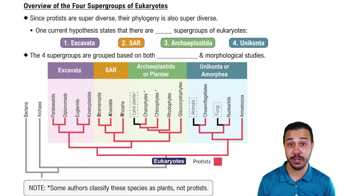According to the phylogeny, which protists are in the same eukaryotic supergroup as plants?
a. Green algae
b. Dinoflagellates
c. Red algae
d. Both A and C
 Verified step by step guidance
Verified step by step guidance Verified video answer for a similar problem:
Verified video answer for a similar problem:



 3:01m
3:01mMaster Overview of the Four Supergroups of Eukaryotes with a bite sized video explanation from Jason
Start learning